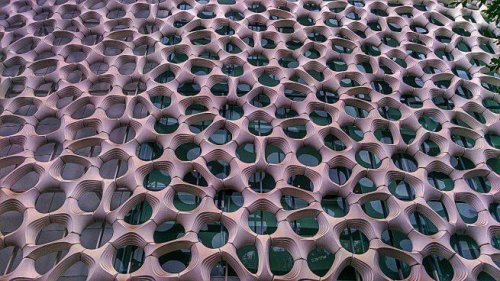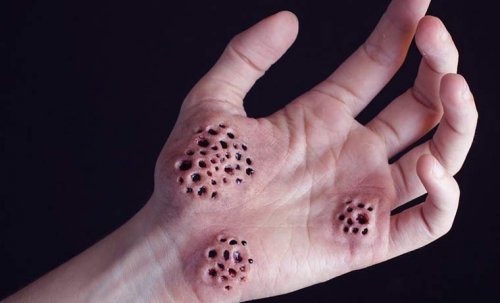Trypophobia: Symptoms, Causes, and Treatments

Trypophobia is an extreme fear or feeling of repulsion toward any pattern of geometric figures that are very close to each other. These figures can be small holes, rectangles, or convex circles. In fact, the word trypophobia literally means “fear of holes”.
This irrational fear is very common in humans, although we currently don’t know much about it. The fact is that millions of people state that they feel repulsion and anxiety when they see patterns of small holes that are close together.

What is a phobia?
Phobias are defined as an intense and irrational fear toward a person, object, or situation that is of little or no danger. The word comes from the Greek phobos, meaning “panic”.
In Greek mythology, Phobos was the son of Ares, God of War, and Aphrodite, Goddess of Love. He personified fear. Alexander the Great prayed to Phobos before each battle to keep fear at bay.
When we speak of trypophobia, we’re referring to a specific phobia characterized by fear or anxiety caused by certain objects or situations. We can call them phobic stimuli. In this case, they’re geometric shapes that are very close together.
Specific phobias, such as trypophobia, have the following characteristics:
- Intense fear or anxiety caused by objects or specific situations (ex. flying, heights, animals, injections, the sight of blood…)
- The phobic situation or object almost always causes immediate fear or anxiety.
- The phobic situation is avoided or actively resisted with strong fear or anxiety.
- The fear or anxiety is disproportionate if we analyze the real level of danger that the object or specific situation presents. This includes the sociocultural context.
- The fear, anxiety, or evasion is persistent and typically lasts six or more months.
- The anxiety, fear, or evasion causes clinically significant discomfort. On the other hand, it might cause social, work-related, or other types of important functional deterioration.
It’s common for people to have multiple specific phobias. Approximately 75% of people with specific phobias fear more than one situation or object.
Trypophobia isn’t considered an illness, but it could become one
People with trypophobia tend to have symptoms of anxiety when they see coral, beehives, soap bubbles, spotted dresses, bubbles, or a bunch of stacked logs.
Feeling aversion at the sight of these geometric figures or holes is not a disease. We consider it a normal and frequent fear in humans. This is because it prevents certain dangers such as contracting diseases or suffering harm.
Nevertheless, this irrational fear could come to interfere with our well-being or daily lives. It could hold us back from having a normal life. In this case, it would translate into a disorder which would have to be dealt with.

What are the causes of trypophobia?
The causes of trypophobia have recently been studied by the University of Essex and have been published in the Psychological Science magazine. The visual patterns that generate anxiety symptoms in people with trypophobia are similar to those caused by various poisonous animals.
So, trypophobia could have an evolutionary explanation. Those who feel disgusted toward these geometric patterns keep a distance from dangerous animals. This would help them survive and avoid being “poisoned or attacked” by these types of animals.
This explanation differs from the causes of other phobias since we learn most irrational fears. We learn to feel fear toward certain stimuli due to personal or external experiences. For example, it could be from observations or what people have told us. With that being the case, trypophobia’s origin doesn’t lie in a trauma. Nor does it have a cultural origin, as is the case with fear of the number 13 or triskaidekaphobia.
Aversion, fear, or disgust toward holes in organic matter is easy to explain. This happens because these images are often associated with diseases.

Symptoms of trypophobia
The symptoms of trypophobia are the same as those of any other specific phobia:
- Excessive, irrational, and persistent fear caused by the presence or anticipation of the source stimulus. In this case, the source stimulus would be the observation of a concrete geometric pattern.
- Anxiety response due to the exposure to or anticipation of the source stimulus. In the most extreme cases, there could be anxiety crises or panic attacks.
- Avoidance of said stimuli or situations in which they could appear.
- Interference in daily life. These avoidance behaviors and the associated anxiety symptoms seriously interfere with different areas of the person’s life.
If you identify with the described symptoms, you may have trypophobia. Nevertheless, you should remember that only a specialist can diagnose you. If this is the case, then the best thing for you to do is to seek the help of a psychologist.

Trypophobia treatments
The treatment of choice for trypophobia is in vivo exposure to the feared stimulus. In this case, it would be to certain geometric figures or images. In some cases, it’s also useful to supplement the in vivo exposure with relaxation techniques.
We can use relaxation as a supplement to exposure. This is because relaxation itself has hardly any therapeutic effects in phobic disorders. Exposing yourself to these geometric figures or groups of holes means being in the feared situation. For example, coming near a certain plant or beehive.
One of the common problems in the treatment of phobias is the appearance of panic attacks. In this sense, it seems that practicing frequent exposure seems to be incompatible with them. Nevertheless, their probability of occurrence increases if the patient interprets the situation as catastrophic. In these cases, you should try to counteract these types of thoughts with other thoughts.
If you have a panic attack, you should try to stay in the situation until it goes away. You should stay as close to the situation as possible and come back to it as soon as possible.
As we’ve seen, trypophobia is an irrational fear of different geometric figures or groups of holes. Like any phobia, it’s a disorder with a solution, as long as a mental health specialist treats it.
All cited sources were thoroughly reviewed by our team to ensure their quality, reliability, currency, and validity. The bibliography of this article was considered reliable and of academic or scientific accuracy.
- Cole, G. G., & Wilkins, A. J. (2013). Fear of Holes. Psychological Science. https://doi.org/10.1177/0956797613484937
- Imaizumi, S., Furuno, M., Hibino, H., & Koyama, S. (2016). Trypophobia is predicted by disgust sensitivity, empathic traits, and visual discomfort. SpringerPlus. https://doi.org/10.1186/s40064-016-3149-6
- Vlok-Barnard, M., & Stein, D. J. (2017). Trypophobia: An investigation of clinical features. Revista Brasileira de Psiquiatria. https://doi.org/10.1590/1516-4446-2016-2079
- Le, A. T. D., Cole, G. G., & Wilkins, A. J. (2015). Assessment of trypophobia and an analysis of its visual precipitation. Quarterly Journal of Experimental Psychology. https://doi.org/10.1080/17470218.2015.1013970
This text is provided for informational purposes only and does not replace consultation with a professional. If in doubt, consult your specialist.








